Robotics
LG invests $60 million in Bear Robotics as robot OS war intensifies
The move comes as Samsung and Naver compete for the fast-emerging robot OS market
By Mar 12, 2024 (Gmt+09:00)
4
Min read
Most Read
LG Chem to sell water filter business to Glenwood PE for $692 million


KT&G eyes overseas M&A after rejecting activist fund's offer


Kyobo Life poised to buy Japan’s SBI Group-owned savings bank


StockX in merger talks with Naver’s online reseller Kream


Meritz backs half of ex-manager’s $210 mn hedge fund


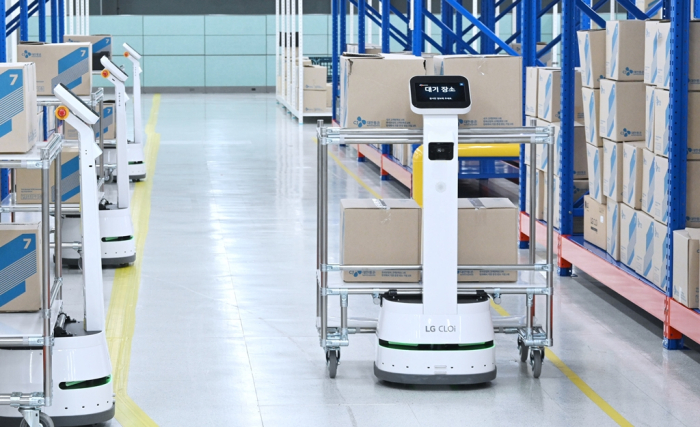
South Korea’s high-tech giant LG Electronics Inc. said on Tuesday it has invested $60 million in Bear Robotics Inc., a Silicon Valley-based service robot startup, as part of LG’s push to nurture robotics as one of its key growth drivers.
With the investment, LG will become the single largest shareholder of Bear Robotics.
“Rather than seeking short-term returns, this strategic investment is aimed at bolstering our portfolio for long-term growth,” LG said in a statement.
Established in 2017, Bear Robotics has gained recognition for its AI-driven autonomous indoor delivery robots. The company’s expertise lies in making platforms for service robotics software and providing robot fleet management technology and cloud-based control solutions.
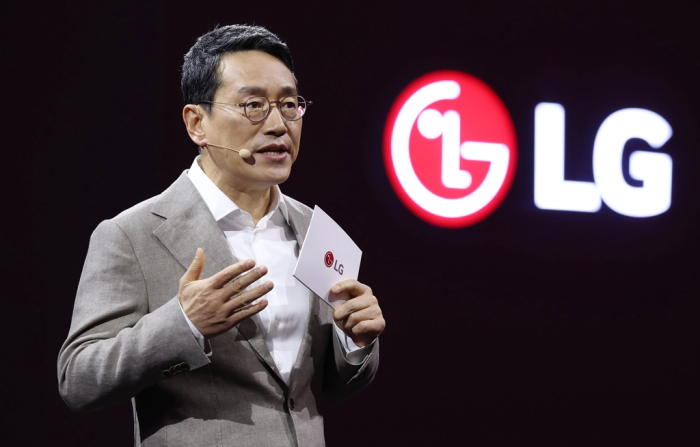
Its service robot, Servi, is already used in restaurants and indoor facilities in several countries, including Korea, Japan and the US.
John Ha, formerly a senior software engineer and technical lead at Google, is the founder and chief executive of Bear Robotics.
LG AIMS TO LEAD SHIFT TOWARD SDR
LG Electronics has been striving to position itself as a leader in the service robotics market.
At CES 2024 earlier this year, LG Chief Executive Cho Joo-wan said, “In the service robotics market, we’re focusing primarily on areas such as delivery and logistics. We’re carefully looking for equity investment or M&A targets.”
LG said it aims to lead the industry shift towards software-defined robotics (SDR), emphasizing the importance of software in the robot industry, similar to the shift seen in the mobility sector.
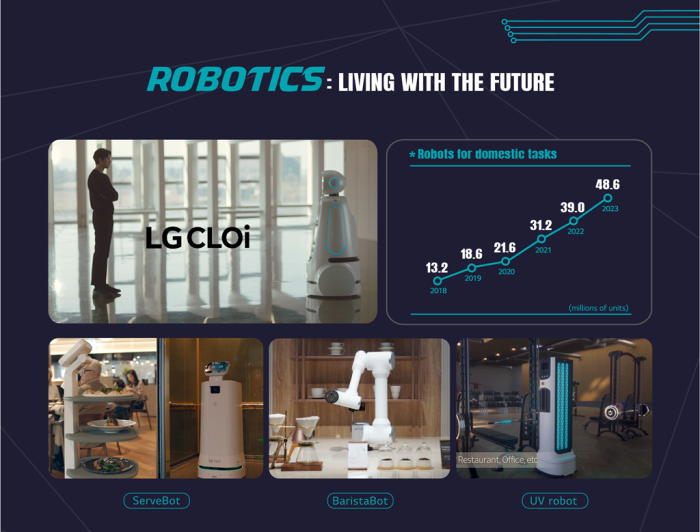
The company said it is committed to developing scalable service robots on an open architecture software platform to cater to a variety of environments, recognizing the importance of standardizing AI-based autonomous robot platforms.
SDR is a concept in robotics that emphasizes the importance of software in the development and operation of robots. It aims to standardize robot platforms and reduce market-entry costs.
“Just as Android revolutionized the smartphone era, standardized open platforms are essential for the activation of the robot market,” said Bear Robotics CEO Ha.
LG’S CLOi ROBOT
LG has already demonstrated its dedication to the robot business with the deployment of its CLOi guide robots at Incheon International Airport in 2017. The company has since expanded its robot services to various commercial spaces, including hotels, restaurants, hospitals, retail stores, museums, smart warehouses and golf courses.
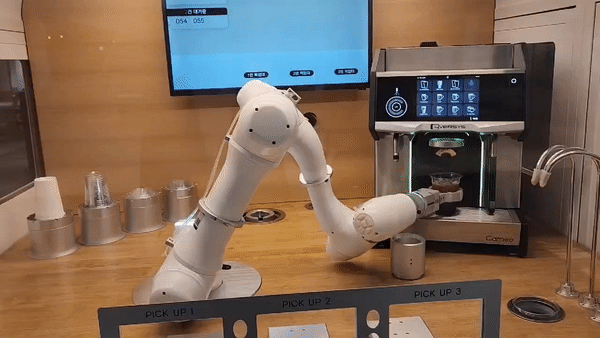
LG operates a service robot production facility at the LG Future Park in Gumi, North Gyeongsang Province.
The service robotics market is expected to take off in the coming years, driven by advancements in AI and communication technologies.
According to industry tracker Research and Markets, the global service robot market is forecast to grow from $15.9 billion in 2022 to $187.3 billion by 2030.
“From a mid- to long-term perspective, we will seek to develop our robot business into a new growth engine, exploring various opportunities through the integration of cutting-edge technologies such as embodied AI and robotic manipulation,” said Lee Sam-soo, LG’s chief strategy officer.
While focusing on commercial robots, LG is also developing butler robots or companion robots for use at home.
During the CES 2024, LG showcased such a robot, “Smart Home AI Agent,” of which it plans to begin mass production early next year.
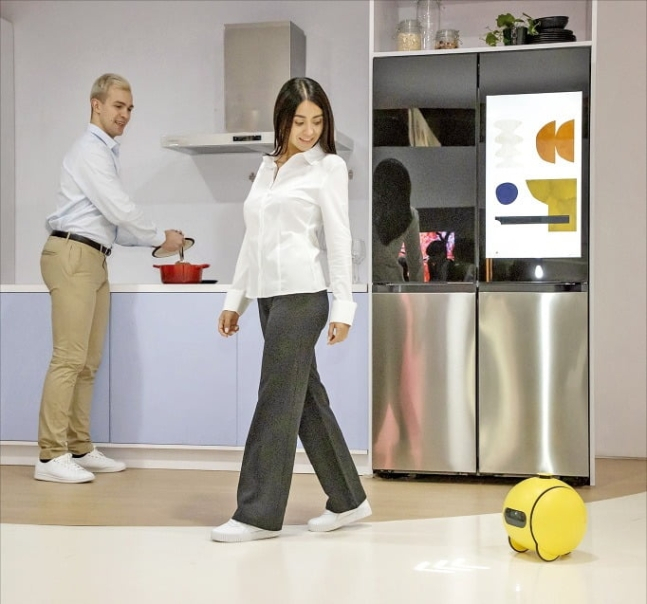
SAMSUNG FOCUSES ON COLLABORATIVE ROBOTS
LG’s crosstown rival Samsung Electronics Co. focuses on collaborative robots that can work together with people.
At CES 2024, Samsung unveiled a generative AI-powered companion robot, Ballie, which learns user patterns and evolves on its own to help users use everyday home appliances, monitor homes and take care of elderly family members or pets.
“Generative AI will serve as an opportunity for all devices, not just robots, to become smarter and further develop,” said Han Jong-hee, Samsung’s vice chairman and Co-CEO.
In 2021, the company expanded its robotics task force unit into a business team.
Last year, it raised its stake in Korean collaborative robot maker Rainbow Robotics Co. to 15% and plans to eventually hike its stake to nearly 60% to control Rainbow.
Samsung also plans to unveil the EX1, a wearable robot, by the end of this year.

RIVALRY IN ROBOT OPERATING SYSTEMS
Tech firms are also fiercely competing in robotics operating systems.
Last week, Naver Corp. unveiled ARC mind, a web platform-enabled robotics OS.
Big Tech companies have already been in the robot software development tool market. Google LLC launched the Google Cloud Robotics Platform, while Amazon Web Services released the AWS RoboMaker.
Samsung’s Ballie is powered by its open-source operating system, Tizen.
The global robot software market is expected to more than quadruple to $69.7 billion by 2032 from $17.3 billion last year, according to industry research firm IMARC Group.
Other Korean firms such as Doosan Robotics Inc. and HD Hyundai Co. are also working to advance their collaborative robot technology.
Last year, Doosan Robotics exported luggage-moving robots to the operator of Amsterdam airport.
Doosan Robotics currently has an annual production capacity of 3,200 robots.
Write to Jeong-Soo Hwang and Chae-Yeon Kim at hjs@hankyung.com
In-Soo Nam edited this article.
More to Read
-
 Mergers & AcquisitionsDoosan Robotics looks for M&A targets post-IPO: CEO
Mergers & AcquisitionsDoosan Robotics looks for M&A targets post-IPO: CEOOct 04, 2023 (Gmt+09:00)
3 Min read -
 RoboticsNaver to unveil world’s first web platform-enabled robotics OS
RoboticsNaver to unveil world’s first web platform-enabled robotics OSMar 05, 2024 (Gmt+09:00)
2 Min read -
 Korean innovators at CES 2024Samsung Electronics expands Tizen OS to AI robot Ballie
Korean innovators at CES 2024Samsung Electronics expands Tizen OS to AI robot BallieJan 15, 2024 (Gmt+09:00)
1 Min read -

-
 RoboticsLG Electronics rolls out third-generation Cloi ServeBot
RoboticsLG Electronics rolls out third-generation Cloi ServeBotApr 11, 2023 (Gmt+09:00)
1 Min read -
 RoboticsSamsung raises Rainbow Robotics stake, eyes management control
RoboticsSamsung raises Rainbow Robotics stake, eyes management controlMar 16, 2023 (Gmt+09:00)
2 Min read -
 RoboticsSamsung Electronics to launch its first robot EX1 this year to rival LG
RoboticsSamsung Electronics to launch its first robot EX1 this year to rival LGFeb 06, 2023 (Gmt+09:00)
2 Min read
Comment 0
LOG IN


